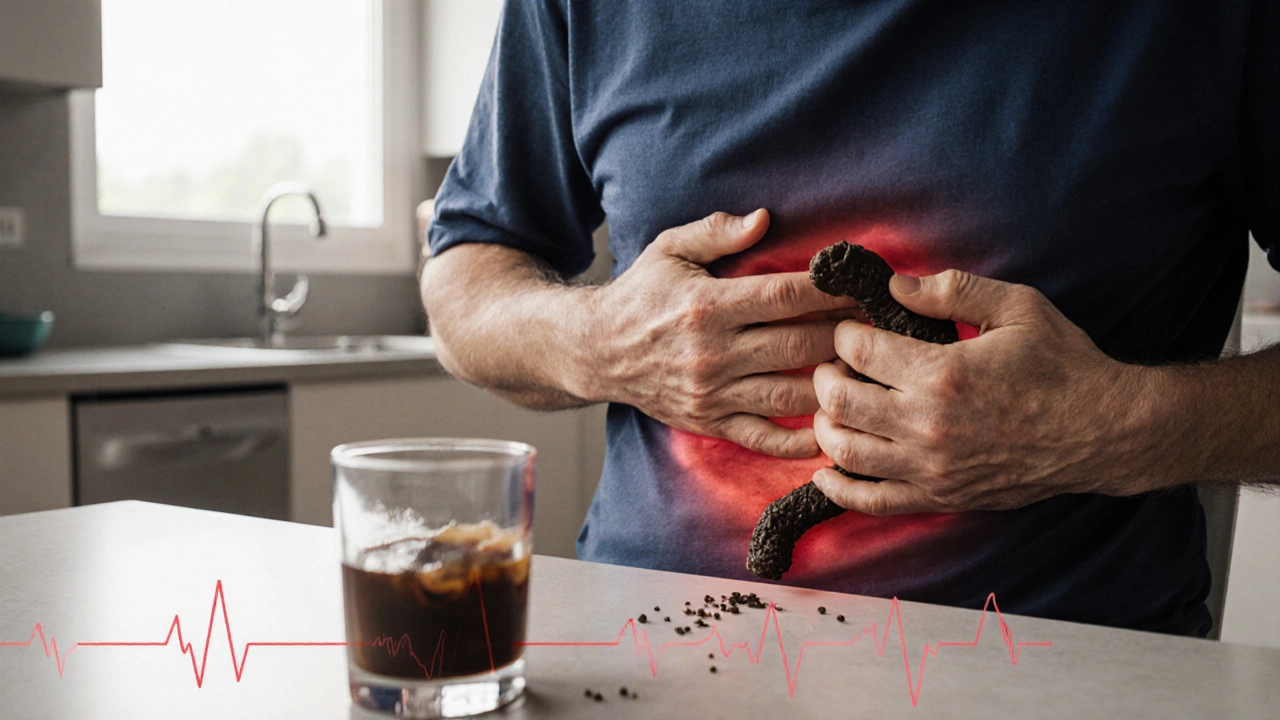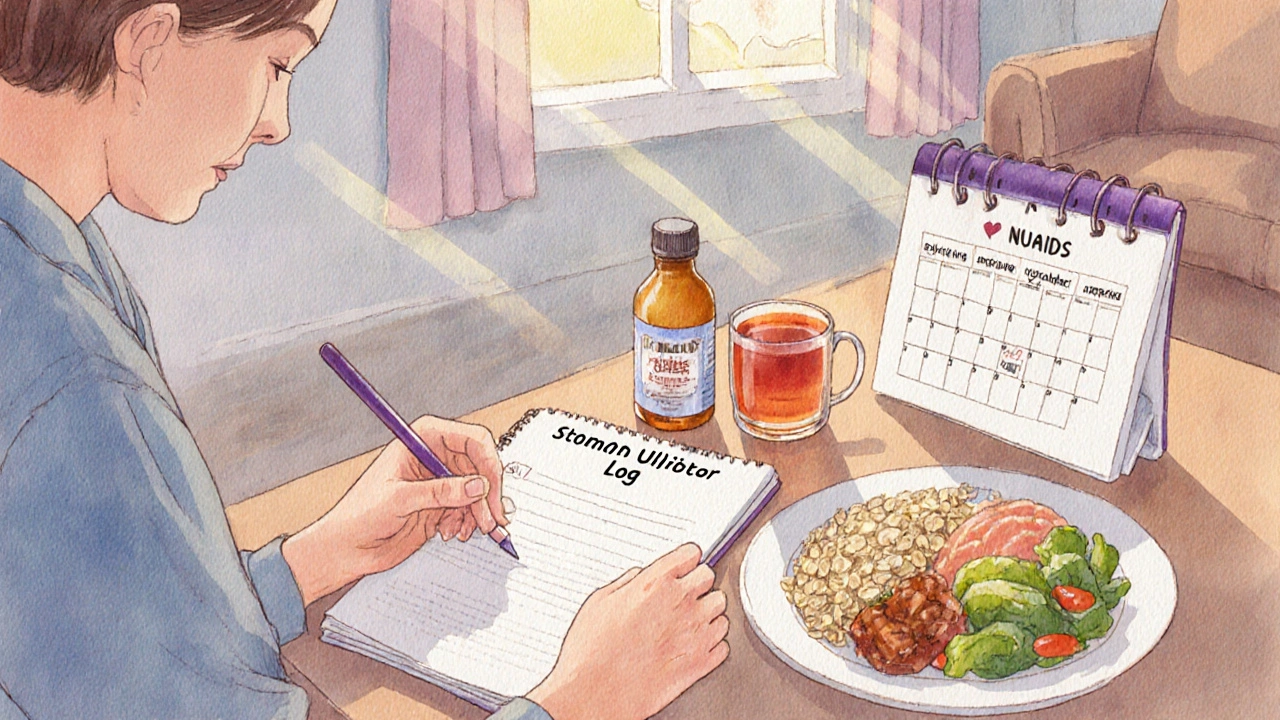Identify and Treat Stomach Ulcer Complications: A Practical Guide

Stomach ulcers can feel like a nagging ache, but when they start causing new problems, the situation changes fast. Knowing the red‑flag signs and the right steps to handle them can stop a mild flare‑up from turning into a serious emergency.
Spotting Warning Signs Early
Most people with a regular ulcer notice a dull gnawing pain that eases after eating. Stomach ulcer complications show up differently - sudden, sharp pain or symptoms that don’t respond to usual antacids. Watch for these clues:
- Bloody or black‑tarry stools (melena) - a sign of hidden bleeding.
- Vomiting bright red blood or material that looks like coffee grounds.
- Severe, worsening abdominal pain that spreads to the back.
- Fever, rapid heartbeat, or sudden dizziness.
- Inability to keep food or liquids down for more than a few hours.
These symptoms often signal that the ulcer has moved beyond a simple lining irritation.
Common Complications and How They Differ
When a stomach ulcer (a type of peptic ulcer that forms in the stomach lining) breaches deeper layers, several complications can arise. Below is a quick comparison.
| Complication | Typical Symptoms | Urgency | Primary Treatment |
|---|---|---|---|
| Gastrointestinal bleeding | Black stool, vomiting blood, drop in blood pressure | High - risk of shock | Endoscopic cauterization, IV fluids, blood transfusion |
| Ulcer perforation | Sudden severe pain, rigid abdomen, fever | Critical - surgical emergency | Emergency surgery to close the hole, antibiotics |
| Gastric outlet obstruction | Persistent vomiting, bloating, weight loss | Moderate - can become severe | Endoscopic dilation, surgery if needed |
Understanding which pattern you’re facing guides the next move.
When to Call a Doctor - No Second‑Guessing
If you notice any of the red‑flag symptoms listed above, pick up the phone right away. Even if you’re not sure, a quick call can save hours of dangerous waiting. Ask for an urgent appointment with a gastroenterologist or go straight to the emergency department if you have vomiting blood or feel faint.

Medical Treatments for Complications
Doctors use a mix of diagnostic tools and therapies to stop the bleed, seal a perforation, or relieve an obstruction.
Endoscopy a minimally invasive procedure that uses a flexible tube with a camera to view the stomach lining and apply treatment is often the first step. During the exam, the physician can:
- Inject a clot‑forming agent to stop bleeding.
- Place tiny clips over a ruptured vessel.
- Take biopsies to check for H. pylori infection a bacterial cause of many ulcers and treat it with a short course of antibiotics.
If bleeding is massive or the ulcer has perforated, surgeons may need to operate. The typical approach for a perforation is a laparoscopic patch that seals the hole and a short regimen of broad‑spectrum antibiotics to prevent peritonitis.
For obstruction, the first line is often endoscopic balloon dilation, which stretches the narrowed passage. When that fails, a partial gastrectomy (removing part of the stomach) may be recommended.
Home Care and Lifestyle Adjustments
Even after hospital care, you’ll spend most of the recovery at home. Here’s what really helps:
- Medication adherence: Finish the full course of proton‑pump inhibitors (PPIs) or H2 blockers prescribed. Skipping doses can let acid restart the ulcer cycle.
- Avoid NSAIDs: Over‑the‑counter pain relievers like ibuprofen and naproxen belong to the NSAID use a common trigger for ulcer formation and complications. Switch to acetaminophen for mild aches, but always ask your doctor first.
- Eat small, frequent meals: This reduces acid spikes and eases the stomach’s workload.
- Limit alcohol and caffeine: Both can irritate the mucosa and increase acid output.
- Quit smoking: Tobacco impairs ulcer healing and raises recurrence risk.
Track any new pain, changes in stool color, or vomiting episodes in a notebook. Bring this log to follow‑up appointments - it helps the doctor spot lingering issues early.

Preventing Future Problems
Once you’ve cleared a complication, the goal shifts to keeping the ulcer from returning.
- Complete the full antibiotic regimen if H. pylori infection was found. A test‑of‑cure breath test after two weeks confirms success.
- Stay on a low‑dose PPI for at least 4-8 weeks after healing, then taper under medical guidance.
- Schedule routine endoscopic check‑ups if you have a history of bleeding or perforation - usually every 1-2 years.
- Maintain a healthy weight through balanced nutrition and regular activity; excess weight can increase abdominal pressure and acid reflux.
- Review all medications with your pharmacist annually, especially if you’re on blood thinners or steroids, which can heighten bleeding risk.
These steps dramatically lower the odds of another episode.
Frequently Asked Questions
Can stress alone cause a stomach ulcer complication?
Stress can worsen ulcer symptoms by increasing acid production, but complications like bleeding or perforation usually require a physical trigger such as H. pylori, NSAID use, or a severe acid breach. Managing stress still matters for overall healing.
Is it safe to take ibuprofen after an ulcer has healed?
Generally not. Even a healed ulcer can reopen if you resume regular NSAID use. If you need anti‑inflammatory relief, discuss alternatives like topical gels or a low‑dose COX‑2 inhibitor with your doctor.
What does a “black stool” indicate?
Black, tarry stools (melena) suggest digested blood from an upper‑GI source, commonly a bleeding ulcer. It’s a medical emergency that needs prompt endoscopic evaluation.
How long does recovery take after ulcer perforation surgery?
Hospital stays range from 5 to 10 days, followed by 4-6 weeks of limited activity. Full recovery, including return to normal diet, often occurs within 2-3 months, depending on age and overall health.
Can a healed ulcer still lead to stomach cancer?
Chronic ulceration, especially from H. pylori, can increase cancer risk over many years. Regular surveillance endoscopy is advised for long‑term sufferers as a precaution.
Tommy Mains
October 12, 2025 AT 02:15If you ever notice black or tarry stools, call your doctor right away.
Those are classic signs of upper‑GI bleeding and need prompt attention.
Also keep a log of any vomiting that looks like coffee grounds, because that tells the ER team where the bleed is coming from.
Stay hydrated with clear fluids while you wait for an appointment, but don’t force yourself to eat large meals.
Remember, stopping NSAIDs and alcohol can keep the ulcer from getting worse.
Alex Feseto
October 19, 2025 AT 00:55In reference to the preceding counsel, it is incumbent upon the patient to recognise that melena denotes a potentially life‑threatening haemorrhage.
Prompt medical evaluation, preferably within a few hours, is thus indispensable.
Moreover, adherence to the prescribed proton‑pump inhibitor regimen cannot be overstated.
vedant menghare
October 25, 2025 AT 23:35From a historical perspective, ulcer disease has been documented in Ayurvedic texts as "ulkus" and in ancient Greek treatises as a malady of the stomach lining.
Modern gastroenterology now understands that the pathogenesis is a delicate balance between aggressive factors such as gastric acid and protective mechanisms like mucosal bicarbonate.
When this equilibrium is disrupted by Helicobacter pylori infection, chronic NSAID use, or severe physiological stress, the mucosa can erode, leading to the complications outlined in the guide.
Bleeding, perforation, and outlet obstruction each present distinct clinical pictures that demand tailored diagnostic and therapeutic strategies.
Endoscopic evaluation remains the gold standard for both diagnosis and initial management, allowing for direct visualization, biopsy, and therapeutic interventions such as clipping or coagulation.
For instance, in cases of active arterial spurting, the deployment of a hemospray or a combination of epinephrine injection and thermal coagulation yields hemostasis in over ninety percent of cases.
When a perforation is identified, laparoscopic repair not only seals the defect quickly but also curtails the inflammatory cascade that can precipitate sepsis.
Antibiotic stewardship is essential; broad‑spectrum agents are indicated peri‑operatively, yet culture‑directed therapy should be pursued whenever possible to mitigate resistance.
Post‑procedure care focuses on gradual reintroduction of nutrition, beginning with clear liquids and advancing to soft, low‑acidic foods as tolerated.
Equally important is the cessation of all ulcerogenic substances, notably non‑steroidal anti‑inflammatory drugs, tobacco, and excessive alcohol consumption.
Lifestyle modification, including stress reduction techniques such as mindfulness meditation, can enhance mucosal healing by lowering circulating cortisol levels.
Patients with a prior bleeding episode should undergo surveillance endoscopy at six‑month intervals for the first year to ensure durable hemostasis.
Furthermore, a repeat urea breath test after eradication therapy confirms the successful elimination of H. pylori, a crucial step in preventing recurrence.
In regions with high gastric cancer incidence, long‑term follow‑up with periodic endoscopic biopsies is recommended, as chronic ulceration may be a precursor to neoplastic transformation.
Ultimately, the synergistic application of evidence‑based medical therapy, vigilant monitoring, and patient education constitutes the most effective defense against ulcer complications.
Kevin Cahuana
November 1, 2025 AT 22:15I totally agree with the comprehensive approach you laid out.
Keep the focus on early endoscopy, and don’t forget to schedule those follow‑up visits.
Also, encouraging patients to maintain a symptom diary can catch relapses before they get serious.
Danielle Ryan
November 8, 2025 AT 20:55Wow!!! This guide is like a secret handbook for the stomach-don’t trust anyone who says ulcers are just “heartburn”!!!
Robyn Chowdhury
November 15, 2025 AT 19:35The discourse surrounding peptic ulcer management often drifts into hyperbole; let us instead anchor our deliberations in empirical evidence. 📜
Deb Kovach
November 22, 2025 AT 18:15Quick tip: after you finish your PPI course, taper the dose gradually rather than stopping cold turkey, and you’ll feel far fewer rebound symptoms 😊.
Sarah Pearce
November 29, 2025 AT 16:55yeah but like if u stop too fast u get that nasty acid surge!!!
Ajay Kumar
December 6, 2025 AT 15:35Hey everyone, just wanted to add that staying hydrated with electrolyte‑rich drinks can actually help your stomach lining recover faster.
Also, try to chew your food thoroughly-digestion starts in the mouth, not just the stomach.
Keep an eye on any sudden weight loss, because that could signal an obstruction.
Richa Ajrekar
December 13, 2025 AT 14:15While your advice is well‑intentioned, it would be prudent to remember that dietary customs vary widely across regions; imposing a singular protocol may unintentionally disregard cultural nuances.